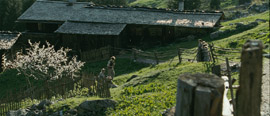Digital Intermediate (DI) is one of today’s most exciting and fastest growing technologies in digital post production of motion picture films. Most individual elements of the process have been around for a long time — digital editing, scanning, digital effects, compositing, and film recording. The latest step in the progression is to apply the process to the entire movie.
Although many post production facilities have developed their own unique DI work flow, there are common elements. After shooting and processing the entire camera negative is usually transferred to NTSC or PAL video for editing. When the cut is locked, the selected shots are scanned in high resolution, color corrected, and recorded back to film. DI gives the cinematographer creative possibilities so far only experienced in color correction for TV and video release.
It is possible, and several productions have done this, to record out a movie in un-spliced 2000 foot (600 m) reels. An advantage of DI is the option to create several negatives, which are used to produce the release prints avoiding any further quality-degrading duplication. Digital mastering preserves the valuable camera negative and there is no need to duplicate material for opticals. Last minute changes of the cut are possible, allowing more editorial flexibility.
The different formats for the digital distribution channel (HD, SD, DVD) can be generated from a single digital master in an as yet unreached high quality since the original camera negative is scanned. So far, many video masters have been produced by transferring an interpositive with a telecine. Finally, the file based DI process creates a collaborative working environment for color correction, visual effects, editing, and mastering.
In spite of all advantages, DI raises concerns among cinematographers. The motion picture system has been producing excellent quality for decades and there is some fear that this quality may degrade. The traditional method for post production of motion picture was relatively simple because there are not many variables available to be controlled. Digital color correction can manipulate the image to practically any degree, leading some cinematographers to wonder if it can maintain the original intent as well.
This document addresses those concerns and tries to explain how the image is captured, encoded and processed. It is also aimed at colorists or scanning and recording operators who want to have a deeper technical understanding of their work.
Figure 1.1. Scene rendered for monitor display.

This image is used to show the formation and encoding of images in the DI process.
If you are viewing this document on a computer you should check the setup of your monitor. Please, adjust brightness and contrast so that you just see some details around the area (2).
The image shows a scene from Joseph Vilsmaier's film Bergkristall. It is reproduced with kindly permission of Perathon Film, München / Clasart Film, München.
The next chapter describes how the tonal composition of a scene is recorded on negative film and transferred to intermediate and print film. Terms like log exposure, transmittance and density are introduced here.
The main focus of the chapter about film scanning is the encoding of image information, that is the representation of scene luminance as numbers in digital files.
A short chapter adds basic information about film recorders.
Like the previous parts, the chapter about digital displays, CRT monitors, and digital projectors concentrates on their grayscale characteristic.
The fundamental concept in those four chapters is the characteristic curve of a system, the relation between input and output signal. The color properties of film and digital displays are described in a separate chapter.
An appendix gives more in-depth information about digital file formats and the color calibration of film scanners and recorders.
The document does not include a glossary, but in the HTML version the reader will find an index for quick location of technical terms in the text.